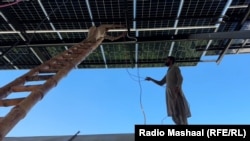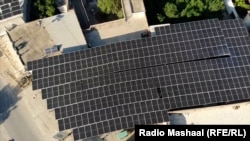As the annual UN climate conference (COP29) takes place in Baku, RFE/RL presents exclusive coverage of environmental issues that are often underreported from regions that are often overlooked.
YAR HUSSAIN, Pakistan -- As world leaders gather in Azerbaijan's capital for the annual United Nations climate conference to plan transitioning away from fossil fuel, policymakers will also address the unforeseen obstacles the green transition might bring.
One such scenario is playing out in Pakistan, where soaring electricity prices have made Pakistan's state-owned power supply among the most expensive in South Asia and pushed cash-strapped households and businesses to find relief from rising costs and rolling blackouts by using low-cost Chinese solar panels.
But the flood of ultracheap solar power -- which has seen Pakistan acquire $1.4 billion worth of Chinese-made solar panels and become the world's third-largest buyer in the first half of 2024 -- also risks exacerbating Pakistan's battered power sector, with a debt exceeding $9 billion and falling grid consumption that could move it toward a new fiscal crisis.
For Nasar Khan, a small business owner from the northern town of Yar Hussain, the switch to solar has eased the sky-high electricity costs that have strained his finances in recent years. The green energy source has lowered his monthly bill by nearly a third, close to what he paid five years ago before a spike in prices triggered by soaring global commodity prices. Those savings, he says, have caught the eye of his neighbors and even his cousin, on whose house he is helping to install Chinese-made solar panels.
"The state power rates have become unaffordable for consumers," Khan told RFE/RL. "Everyone who can [afford to] is now trying to switch to solar."
Khan and his neighbors in Yar Hussian are hardly the only ones. Across the country of 240 million people, shimmering blue panels dot the rooftops of cities and cover factory buildings as the mass adoption of solar panels sweeps Pakistanis looking to blunt the impact of soaring state energy tariffs.
While this may be good news for the environment and global efforts to adopt cleaner forms of energy production, the shift could bring new headaches for the government as demand for energy from the state power grid shrinks and Islamabad juggles its tenuous financial outlook with the corresponding drop in revenue.
Kaiser Bengali, an economist who worked as an adviser to the chief minister of Pakistan's southeastern Sindh Province, says the influx of Chinese panels has sparked an episode of "circular debt" where those left reliant on the expensive state power grid need to choose between saving money to switch to solar or refuse to pay their bills -- which could, in turn, spark a cascade of unpaid debt from one government company to another.
"[This] means there is a water-supply company that is providing water to us and, of course, they use power, because water has to be pumped," Bengali told RFE/RL. "But if people don't pay their water bills then the water company can't pay the electricity company. And because the electricity company is using gas, they can't pay the gas company, and so on."
Consumption of electricity from the national grid fell by 10 percent in 2023 compared to the previous year amid rising electricity prices and this decrease could deepen as Islamabad faces pressure to increase electricity prices in budget-balancing moves to repay a loan from the International Monetary Fund (IMF).
Pakistanis Looking Off Grid
Against this backdrop, Pakistanis are adapting however they can.
It's not clear exactly how many people are switching to solar panels as an alternative source of electricity. Some households have opted for simple set-ups for their own needs, while others have invested large sums in hopes of selling the energy to the national grid.
Abrar Khan, from the Swabi district in Khyber Pakhtunkhwa Province, says he has been fitting solar-panel systems on houses and businesses for 20 years, but the energy crisis and falling trust in the government's ability to resolve it has triggered a major uptick in installations.
"Domestic and industrial users were fed up with high rates and frequent power outages," he told RFE/RL. "This is why this year and the past year the demand for solar systems has increased enormously."
The roots of Pakistan's power-sector crisis go back decades but picked up steam in 1994 when Islamabad offered lucrative deals to foreign investors to build power plants as the government and its rapidly growing population pursued economic growth.
Called independent power producers (IPPs), these operators secured liberal provisions from the government in the form of sovereign-backed, dollar-indexed returns and commitments to pay for even unused electricity.
Financing mostly flowed to the coal-fired or gas-fueled plants, which left electricity prices largely tied to fluctuations in the global market for fossil fuels, with power tariffs in Pakistan more than doubling in the past three years alone.
The government also scaled-back subsidies and passed the capacity payments made to power producers to consumers, a bane for large sections of society in a developing country like Pakistan where roughly 40 percent of the population lives below the UN-defined poverty line.
Industrial groups complain that energy costs are double those of businesses in India and Bangladesh, and some factories have been forced to shut down.
"Whoever's business is surviving -- [and] I am among them -- it's because of using these solar-energy systems," Ijaz Bacha, a factory owner and spokesman for the marble industry in Khyber Pakhtunkhwa Province, told RFE/RL.
Marble processing is a major industry in the province, and Bacha says between 30 percent and 40 percent of manufacturers there have gone out of business in the past two years.
Bacha says the electricity bill for his facility has dropped significantly since he switched to solar, with his monthly bill going from 2 million rupees ($7,300) to 1.2 million rupees ($4,300). He adds that those savings have kept his business afloat but were only possible thanks to a 25 million rupee ($90,000) investment, a sum many Pakistani business owners would have difficulty raising.
"I believe that in the next year, the majority of the industries [in Pakistan] will switch to solar because survival is impossible without it," Bacha said.
Grappling With Uncertainty
In navigating the intertwined debt and energy problems, consumers say they're dealing with policy whiplash.
In 2017, Pakistan started a system for "net metering" where people can sell excess electricity produced by their solar panels back to the national grid. But in March, the government indicated it wanted to end the net-metering policy to meet IMF criteria for state spending as it tries to stabilize its economy.
Despite concern from the federal government, the provincial governments of Punjab -- home to more than half of the country's population -- and Sindh (more than 50 million people) are now offering free or subsidized solar panels to help low-income households.
The federal government is also renegotiating debts, with the hope of stabilizing the grid and reducing its reliance on fossil fuels.
Pakistani Energy Minister Awais Leghari told the Financial Times in September that the government was renegotiating with Chinese and domestic investors over power-sector debts and exploring ways to privatize certain companies.
But the minister also expressed concern that the continued interest and use of solar panels risks making the grid "unaffordable" due to a sustained loss of paying customers.
"Demand is shrinking off the grid. That's a big concern for us," he said.













